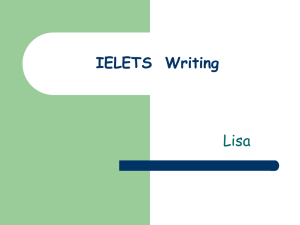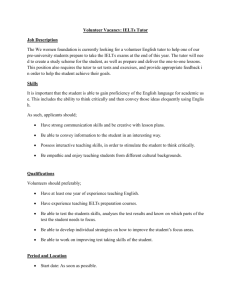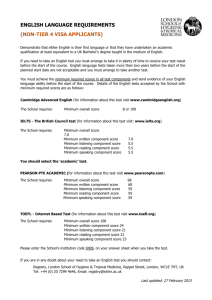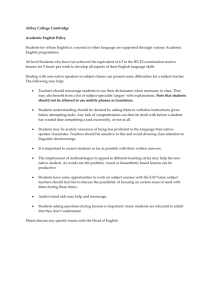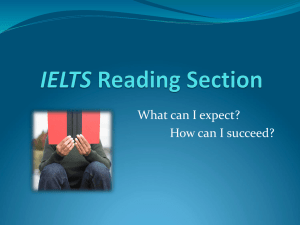Let`s Read!
advertisement
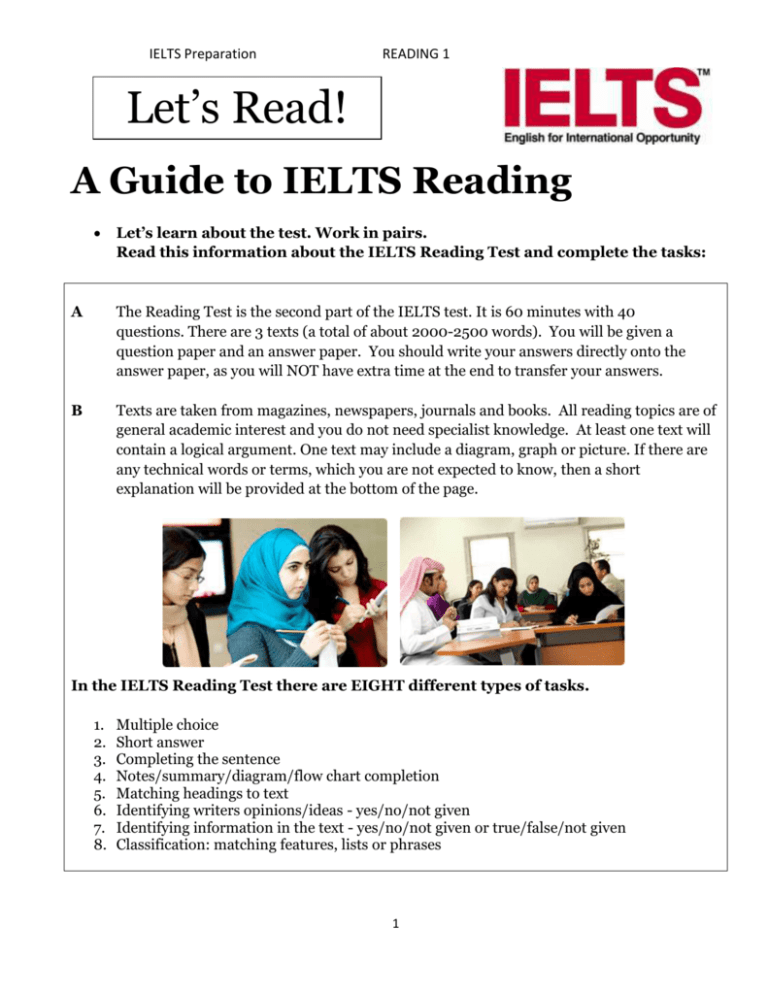
IELTS Preparation READING 1 Let’s Read! A Guide to IELTS Reading Let’s learn about the test. Work in pairs. Read this information about the IELTS Reading Test and complete the tasks: A The Reading Test is the second part of the IELTS test. It is 60 minutes with 40 questions. There are 3 texts (a total of about 2000-2500 words). You will be given a question paper and an answer paper. You should write your answers directly onto the answer paper, as you will NOT have extra time at the end to transfer your answers. B Texts are taken from magazines, newspapers, journals and books. All reading topics are of general academic interest and you do not need specialist knowledge. At least one text will contain a logical argument. One text may include a diagram, graph or picture. If there are any technical words or terms, which you are not expected to know, then a short explanation will be provided at the bottom of the page. In the IELTS Reading Test there are EIGHT different types of tasks. 1. 2. 3. 4. 5. 6. 7. 8. Multiple choice Short answer Completing the sentence Notes/summary/diagram/flow chart completion Matching headings to text Identifying writers opinions/ideas - yes/no/not given Identifying information in the text - yes/no/not given or true/false/not given Classification: matching features, lists or phrases 1 IELTS Preparation READING 1 Let’s practice the EIGHT different types of tasks: 1. Multiple choice (Circle the correct answer) The Reading Module is the … part of the test. a. first b. second c. third d. fourth 2. Short answer questions Answer these questions using NO MORE THAN THREE WORDS for each answer. 1. Where do the texts come from? ………………………………………………….… and newspapers, 2. What kind of argument will be in one or more passages? ………………………..…………..…….. 3. In one text there may be three extra sources of information. What are they? ……………….………………………………………………………………………..…. 3. Completing the sentence Answer these question using NO MORE THAN THREE WORDS for each answer. If there is a difficult word which needs specialist knowledge, you will be given a/an ……………………..…………………………………………………………………………………………… . 4. Notes/summary/diagram/flow chart /table completion Complete the table below. Choose NO MORE THAN THREE WORDS / NUMBERS from the text for each answer. IELTS Reading Module 1. ……………………………………………………. Questions Type of text 2. ……………………………………………………. Interest Number of texts 3. ……………………………………………………. Time for test 4. ……………………………………………………. Minutes 5. Matching headings Choose the correct heading for paragraphs A and B from the list of headings below. Write the correct number 1 to 4 in boxes 1 and 2. 1. Paragraph A …… 2. Paragraph B …… 1. 2. 3. 4. The Listening Test Texts in the Reading Test Introduction to the Reading Test Matching Headings in the Reading Test 2 IELTS Preparation READING 1 6. Identifying the writer’s opinions or views. Read paragraph C below and complete the tasks. C The reading module may be difficult, but if you prepare carefully and practise a number of different reading activities, you should be successful. The exam is only 60 minutes, with no extra time for writing your answers. This means you must write all your answers neatly, with good spelling and grammar, on the answer sheet. Do the following statements agree with what the writer says in Paragraph C? In boxes 1-4 on your answer sheet write: Yes If the statement agrees with the writer. No If the statement does not agree with the writer. Not Given If it is impossible to say what the writer thinks about this. a. The reading test is not always easy. b. The reading test is more difficult that the listening test. c. You should be successful in the reading test if you prepare well. d. Spelling and grammar are important. 1. 2. 3. 4. 7. Read paragraphs A, B and C again. Are these statements TRUE, FALSE or NOT GIVEN (i.e. there is no information). 1. 2. 3. 4. The Reading Test is the third part of the IELTS exam. The Reading Test is a one hour test. The second passage is always the most difficult. There is extra time for writing your answers. ……………………… ……………………… ……………………… ……………………… 8. Classification: matching features, lists or phrases Classify the following statements about paragraph C as being… A an opinion of the writer of the paragraph B how to prepare for the exam C the length of the exam Write the correct letter, A, B, or C, in boxes 1-3 on your answer sheet. Answers 1. The exam is one hour long. 2. The exam is not easy, but it’s not impossible. 3. Practise a range of different activities. 3 IELTS Preparation READING 1 Let’s practise some of the skills we have studied. Read the passage and answer the questions. At the same time, the warmer, less saline water in warmer parts of the world travels along the surface of the sea to the poles. Then its salinity increases and it sinks. However, as the salinity of the water at the poles decreases, this process slows down. As this happens, it may have dramatic consequences for sea life. For many years scientists have stated that the main effect of global warming is the melting of the polar ice caps, resulting in a rise in sea levels. However as we observe the theory become a reality, it is clear that this action also has many other effects. A second discovery is that the sea has played a role in reducing global warming. Oceans hold a certain amount of carbon dioxide. As the temperature of the sea rises, its capacity to hold CO2 falls. This increases the problem of global warming. However, there is a piece of good news! Melting ice-caps and lower saline levels enable the sea to hold more carbon dioxide, so the problem is delayed. Fresh water from melting caps flows into the sea, reducing the concentration of salt in the water and the sea’s density, making the sea less dense. Salinedense water normally sinks to the bottom of the sea and then travels to warmer equatorial regions. Multiple choice with single answers. This task usually focuses on one part of the text. The questions will always follow the order of the text. All the answers may be correct, but your answer must be true to the text. Choose the correct letter A, B, C, or D. 1. What do the experts say are the effects of global warming? A. There will be a higher rainfall. B. There will be more violent storms. C. The ice-caps will melt. D. Animal and plant life will move further North. 2. Scientists say that the rising sea levels… A. have many different consequences. B. will have many benefits to sea life. C. have led to more mosquitoes than before. D. means that polar bears will disappear. Multiple choice with multiple answers. You will have to select a number of options. Your selections must be correct according to the text. Which TWO statements are true according to the text. Circle the letters. A. B. C. D. E. Rivers will flood their banks when the sea level rises. Warmer water holds less carbon dioxide. This worsens the global warming problem. Sea life will die out because of less oxygen in the sea water. Scientists think that global warming causes the polar ice-caps to melt. Polar bears will lose their fur because of the change in temperature. 4 IELTS Preparation READING 1 Complete the Sentences. There are two types of sentence completion tasks. In the first type, you must complete a sentence using exactly the same words as in the text. Don’t write more than THREE words. Your answer will be wrong if you do. Complete the sentences below with words taken from the text. Use no more than THREE words for each answer. 1. Water from frozen ice caps melts and flows …………………………………………... . 2. This lowers the …………………………………………... of salt in the water. 3. Water with a high …………………………………………... usually sinks to the bottom of the sea. In the second type, you have to complete sentences from a list of options. Complete each sentence with the correct ending A-G from the box below. 1. 2. 3. 4. 5. Fresh water from melting ice-caps… Scientists say that global warming… Lower saline levels… A theory about global warming… Saline dense water… A. B. C. D. E. F. G. melts the polar ice-caps. sinks to the bottom of the sea. creates mountains in sea. has killed all the polar bears. let the sea hold more CO2. flows into the sea. was formed by scientists. YES, NO or NOT GIVEN Look at the statements in bold and answer… YES, NO or NOT GIVEN. 1. 2. 3. 4. Scientists are shocked by the effects of global warming. Saline dense water travels to warmer equatorial regions. There is some good news about the melting of the ice-caps. Saline dense water damages our health. ……… ……… ……… ……… Label the diagram. Choose no more than THREE WORDS from the passage for each answer. 1. …………………………… flows into the sea. 2 …………………………… usually sinks to the bottom of the sea. 5
